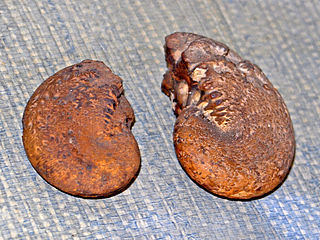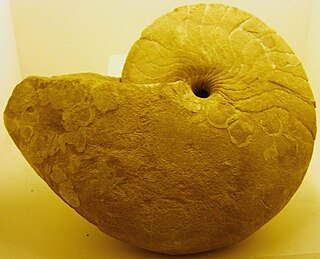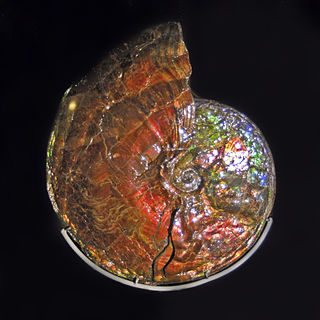
Ammonoids are extinct spiral shelled cephalopods comprising the subclass Ammonoidea. They are more closely related to living coleoids than they are to shelled nautiloids. The earliest ammonoids appeared during the Devonian, with the last species vanishing during or soon after the Cretaceous–Paleogene extinction event. They are often called ammonites, which is most frequently used for members of the order Ammonitida, the only remaining group of ammonoids from the Jurassic up until their extinction.

Ammonitida or "True ammonites" are an order of ammonoid cephalopods that lived from the Jurassic through Paleocene time periods, commonly with intricate ammonitic sutures.

The Phylloceratina comprise a suborder of ammonoid cephalopods, belonging to the Ammonitida, whose range extends from the Lower Triassic to the Upper Cretaceous. Shells of the Phylloceratina are generally smooth with small to large umbilici and complex sutures with leaf-like phylloid saddle endings and lobes with thornlike projections.
The Nautilina is the last suborder of the Nautilida and the only nautiloids living since the end of the Triassic. The Nautilina, proposed by Shimanskiy, is basically the Nautilaceae of Kummel, 1964, defined by Furnish and Glenister, but differs in omitting two families, the Paracenoceratidae and Pseudonautilidae which instead are placed in the Liroceratina.

Lytoceratina is a suborder of Jurassic and Cretaceous ammonites that produced loosely coiled, evolute and gyroconic shells in which the sutural element are said to have complex moss-like endings.

Ammonitina comprises a diverse suborder of ammonite cephalopods that lived during the Jurassic and Cretaceous periods of the Mesozoic Era. They are excellent index fossils, and it is often possible to link the rock layer in which they are found to specific geological time periods.
Zetoceras is an extinct ammonoid cephalopod genus from the suborder Phylloceratina that lived during the Early and Middle Jurassic in what is now Europe, and is included in the (family) Phylloceratidae.
Ancyloceratoidea, formerly Ancylocerataceae, is a superfamily of typically uncoiled and loosely coiled heteromorph ammonoids established by Alpheus Hyatt in 1900, that may contain as many as 11 families, depending on the classification accepted.

Hercoglossidae is a family of nautilid cephalopods in the superfamily Nautilaceae. It was established by Spath in 1927 for smooth, involute nautiloids characterized by a suture with differentiated elements, known from the Upper Jurassic to the Oligocene.
The Clydonautiloidea are a superfamily within the nautiloid order Nautilida characterized by smooth, generally globular, shells with nearly straight sutures, in early forms, but developing highly differentiated sutures in some later forms. Where known, the siphuncle tends to be central to subcentral.

Stephanoceratoidea, formerly Stephanocerataceae, is a superfamily of middle- upper Jurassic ammonoid cephalopods within the order Ammonitida containing diverse forms, generally with sharp ribbing and complex suture lines. Aptychi are believed to be mostly granular (Granulaptycus) or concentrically ribbed on the surface (Praestriaptychus)

Discophyllitidae are discoidal, generally evolute Phylloceratina from the Upper Triassic, derived from the Ussuritidae, in which the principal saddles of the suture have bifurcated or trifurcated endings, described as being di- or triphyllic. Discophyllitid shells are rather similar to those of the ancestral Ussuritidae and are distinguished primarily by the more complex suture. The Discophyllitidae provided the source for the Jurassic Phylloceratidae and Juraphyllitidae. Four genera are recognized and described.

Juraphyllitidae is a family of Lower Triassic phylloceratin ammonites from Europe, North Africa, and Asia characterized by narrow, evolutely coiled shells, usually with coarse ventral ribbing on the body chamber. The first lateral saddles in the suture are diphyllic, with two terminal branches, others exposed sutural saddles are diphyllic or triphyllic, those covered by successive whorls being monophyllic. A few genera are more involute, with successive whorls partially embracing the flanks of the previous. All are compressed and a few lack ribbing.
Pseudonautilidae is a family of Jurassic and Lower Cretaceous nautilid cephalopods belonging to the same superfamily as modern Nautilus, Nautilaceae, but forming a different branch from the family Nautilidae. Pseudonautilids, together with other nautilids, were contemporary with the ammonoids, which comprise an entirely different set of shelled cephalopod stocks more closely related to octopus and squid.

Placenticeratidae is an extinct family of mostly Late Cretaceous ammonites included in the superfamily Hoplitoidea, derived from the Engonoceratidae by an increase in suture complexity.

Lytoceratidae is a taxonomic family of ammonoid cephalopods belonging to the suborder Lytoceratina, characterized by very evolute shells that generally enlarge rapidly, having whorls in contact but mostly overlapping very sightly, or not at all.
Brancoceratidae is a family of acanthoceratoid ammonites from the middle of the Cretaceous, recognized by their commonly evolute shells with round, oval, or quadrate whorls, strong ribs, usual ventral keels, and at least, umblical tubercles. The family is thought to be derived from the Desmoceratidae (Desmoceratoidea), perhaps from Silesitoides or some allied genus.

Calliphylloceras is an ammonite belonging to the Phylloceratidae.
Oppeliinae is a subfamily within the Oppeliidae, a family of Jurassic ammonites characterized by forms that are mainly oxyconic, compressed with sharp venters, in the adult and with keeled inner whorls. Sutures are complex, consisting of a long series of evenly graded lobes and saddles with finely frilled endings.
Streblitinae is a subfamily of Upper Jurassic and Lower Cretaceous ammonites within the family Oppeliidae characterized by compressed, involute shells; typically oxycones with complex sutures. Includes Streblites, Pseudoppelia, and Substreblites. Derivation is from the Taramelliceratinae. May have given rise to the Aconiceratinade.











